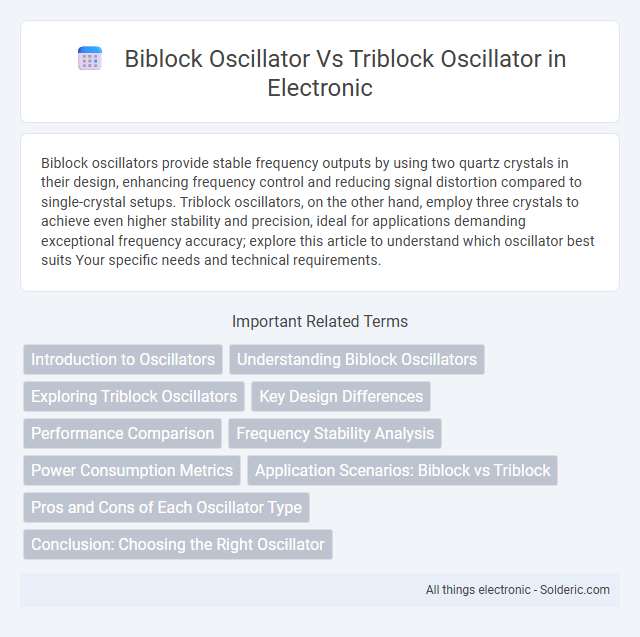Biblock oscillators provide stable frequency outputs by using two quartz crystals in their design, enhancing frequency control and reducing signal distortion compared to single-crystal setups. Triblock oscillators, on the other hand, employ three crystals to achieve even higher stability and precision, ideal for applications demanding exceptional frequency accuracy; explore this article to understand which oscillator best suits Your specific needs and technical requirements.
Comparison Table
| Feature | Biblock Oscillator | Triblock Oscillator |
|---|---|---|
| Structure | Two active blocks | Three active blocks |
| Frequency Stability | Moderate stability | Higher stability |
| Complexity | Simple design | More complex design |
| Power Consumption | Lower power usage | Higher power usage |
| Applications | Basic timing and signal generation | Advanced timing, precise signal generation |
| Phase Noise | Higher phase noise | Lower phase noise |
Introduction to Oscillators
Biblock oscillators consist of two oscillating blocks that generate stable frequency signals with relatively simple circuitry, making them suitable for basic timing applications. Triblock oscillators incorporate three oscillating blocks, offering enhanced frequency stability and reduced phase noise, which improves performance in more demanding signal processing tasks. Your choice between biblock and triblock oscillators depends on the required precision and complexity of the electronic system.
Understanding Biblock Oscillators
Biblock oscillators utilize two coupled resonant circuits to generate stable oscillations at specific frequencies, often improving frequency selectivity and reducing phase noise compared to single-block designs. These oscillators are advantageous in applications requiring precise frequency control, such as communication systems and signal generation. By contrast, triblock oscillators incorporate three resonant elements, offering enhanced frequency stability and higher harmonic suppression but at the cost of increased circuit complexity and power consumption.
Exploring Triblock Oscillators
Triblock oscillators offer enhanced frequency stability and lower phase noise compared to traditional biblock oscillators due to their three-stage feedback loop design. The additional stage in triblock oscillators enables finer frequency tuning and improved harmonic suppression, making them ideal for high-precision signal generation. This advanced architecture is widely used in applications requiring stable multi-phase clock signals and robust oscillation under varying environmental conditions.
Key Design Differences
Biblock oscillators utilize two active amplifying stages, which offer simpler design and reduced power consumption, while triblock oscillators incorporate three amplifying stages, enhancing frequency stability and output signal purity. The additional stage in triblock designs improves gain margin and phase noise performance but increases circuit complexity and power requirements. Design trade-offs revolve around achieving optimal signal integrity versus minimizing component count and energy usage.
Performance Comparison
Biblock oscillators generally offer improved frequency stability and lower phase noise compared to triblock oscillators due to their simpler architecture and reduced parasitic effects. Triblock oscillators may provide higher gain and broader tuning range but often suffer from increased power consumption and lower spectral purity. For your application, choosing between biblock and triblock oscillators depends on prioritizing either signal fidelity or frequency agility.
Frequency Stability Analysis
Bi-block oscillators exhibit moderate frequency stability due to their simpler design, which limits phase noise suppression and temperature drift compensation. Tri-block oscillators provide enhanced frequency stability by incorporating additional feedback loops that improve phase noise performance and reduce sensitivity to environmental variations. Frequency stability analysis shows tri-block designs maintain consistent oscillation frequency with lower phase jitter and better long-term stability compared to bi-block oscillators.
Power Consumption Metrics
Biblock oscillators typically exhibit lower power consumption metrics compared to triblock oscillators due to their simpler design and fewer active components. Triblock oscillators, while offering enhanced stability and frequency control, consume more power as a result of their increased circuit complexity and additional blocks. Optimizing Your application for power efficiency often favors biblock oscillators when minimal energy use is a priority.
Application Scenarios: Biblock vs Triblock
Biblock oscillators excel in applications requiring stable frequency generation with moderate complexity, such as simple RF circuits and low-power signal processing. Triblock oscillators are preferred in advanced scenarios demanding higher frequency stability and phase noise reduction, including telecommunications and precision instrumentation. Your choice depends on the need for performance versus system complexity in specific electronic designs.
Pros and Cons of Each Oscillator Type
Biblock oscillators offer simpler circuit design and lower power consumption, making them ideal for applications requiring minimal complexity and efficient energy use; however, they may suffer from less frequency stability and limited tuning range. Triblock oscillators provide enhanced frequency stability and wider tuning capabilities thanks to their more complex architecture, which improves precision in signal generation but results in higher power consumption and increased circuit complexity. Selecting between biblock and triblock oscillators depends on the specific needs for stability, power efficiency, and design simplicity in the target application.
Conclusion: Choosing the Right Oscillator
Biblock oscillators offer simplicity and lower power consumption, making them ideal for applications requiring basic frequency generation with minimal complexity. Triblock oscillators provide enhanced stability and precision due to their additional block, suitable for high-frequency and low-noise environments. Selecting the right oscillator depends on balancing performance requirements, power constraints, and application-specific needs.
biblock oscillator vs triblock oscillator Infographic

 solderic.com
solderic.com